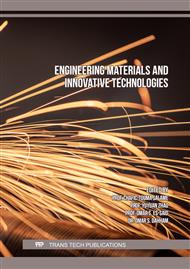[1]
M. R. Zuriadi, A. Fadli, and A. Amri, Pelapisan permukaan stainless Steel 316L menggunakan hidroksiapatit dengan metode deposisi, J. Online Mhs. Fak. Tek. Univ. Riau, 20, 2, (2015) 1–7.
Google Scholar
[2]
S. A. Abdulrahmana, Q. A. Hamad, and J. K. Oleiwi, Investigation of some properties for laminated composite used for prosthetic socket, Engineering and Technology Journal,.39, 11, (2021) 1625-1631.
DOI: 10.30684/etj.v39i11.2050
Google Scholar
[3]
J. A. Helsen, Metals as biomaterials, John Wiley & Sons, New York, (1998), 153.
Google Scholar
[4]
J. Liu et al., Effect of low-temperature plasma carbonitriding on the fretting behaviour of 316LVM medical grade austenitic stainless steels, Wear, 271, 9–10, (2011) 1490–1496.
DOI: 10.1016/j.wear.2010.12.017
Google Scholar
[5]
K. P. Ananth, J. Sun, and J. Bai, Superior corrosion protection and in vitro biocompatibility of Na-HAp/CS composite coating on PoPD-coated 316L SS, Materials Today Chemistry, 10, (2018) 153-166.
DOI: 10.1016/j.mtchem.2018.08.001
Google Scholar
[6]
M. Cheng, W. Cao, Y. Gao, Y. Gong, N. Zhao, and X. Zhang, Studies on nerve cell affinity of biodegradable modified chitosan films, J Biomater Sci Polym Ed, 14, 10, (2003) 1155–1167.
DOI: 10.1163/156856203769231628
Google Scholar
[7]
D. Wei, W. Sun, W. Qian, Y. Ye, and X. Mac, The synthesis of chitosan-based silver nanoparticles and their antibacterial activity, Carbohydrate Research, 344, 17, (2009) 2375-2382.
DOI: 10.1016/j.carres.2009.09.001
Google Scholar
[8]
M. Ø. Dalheim, J. Vanacker, M. A. Najmi, F. L. Aachmann, B. L. Strand, and B. E. Christensen, Efficient functionalization of alginate biomaterials, Biomaterials, 80, (2016) 146-156.
DOI: 10.1016/j.biomaterials.2015.11.043
Google Scholar
[9]
S. M. Gupta and M. Tripathi, A review of TiO2 nanoparticles, Chinese Science Bulletin, 56, 16, (2011) 1639–1657.
DOI: 10.1007/s11434-011-4476-1
Google Scholar
[10]
J. K. Savaiano and T. J. Webster, Altered responses of chondrocytes to nanophase PLGA/nanophase titania composites, Biomaterials, 25, 7-8, (2004) 1205–1213.
DOI: 10.1016/j.biomaterials.2003.08.012
Google Scholar
[11]
D. B. Haddow, S. Kothari, P. F. James, R. D. Short, P. V. Hatton and R.V. Noort, Synthetic implant surfaces. 1. The formation and characterization of sol-gel titania films, Biomaterials, 17, 5, (1996) 501-507.
DOI: 10.1016/0142-9612(96)82724-4
Google Scholar
[12]
M. Kulkarni, A. Mazare, P. Schmuki, and A. Iglič, Biomaterial surface modification of titanium and titanium alloys for medical applications, Nanomedicine, 111, 615, (2014) 111.
Google Scholar
[13]
H. M. Algailani, A.l K. Mahmoud, and H. A. Al-Kaisy, Fabrication of Ni-ZrO2 Nanocomposite Coating by Electroless Deposition Technique, Engineering and Technology Journal, 38, 5, (2020) 649-655.
DOI: 10.30684/etj.v38i5a.491
Google Scholar
[14]
R. A. Isaa., M. N. Al-Shroofy. and H. A. Al-Kaisy, Al2O3-TiO2-PMMA Bio-Composite Coating via Electrostatic Spray Technique, Engineering and Technology Journal, 39, 3A, (2021) 504-511.
DOI: 10.30684/etj.v39i3a.1894
Google Scholar
[15]
J. Scheirs, Compositional and failure analysis of polymers: a practical approach, John Wiley & Sons, (2000) 600.
Google Scholar
[16]
M. L. Duarte, M. C. Ferreira, M. R. Marvao, and J. Rocha, an Optimised method to determine the degree of acetylation of chitin and chitosan by FTIR spectroscopy, Int J Biol Macromol, 31, 1-3, (2020) 1–8.
DOI: 10.1016/s0141-8130(02)00039-9
Google Scholar
[17]
X. Wang, J. Wang, and H. Wang, Synthesis, characterization and ceramization of a novel vinyl-rich liquid precursor for Si(O)C ceramic, Ceramics Int, 39, 9, (2013) 9033–9039.
DOI: 10.1016/j.ceramint.2013.04.106
Google Scholar
[18]
Q. A. Hamad, J. K. Oleiwi, and N. N. Kadhim, f Influence of pistachio shell powder reinforcement on FTIR and DSC behavior of PMMA acrylic resin, Iraqi J. Mech. Mater. Eng., 20, 1, (2020) 63–76.
DOI: 10.32852/iqjfmme.v20i1.462
Google Scholar
[19]
J. K. Oleiwi, Q. A. Hamad, and S. A. Abdulrahman, Comparative study of polymeric laminated composites reinforced by different fibers of prosthetic socket by DSC and FTIR, Key Engineering Materials, 911, (2022) 3-8.
DOI: 10.4028/p-ju39wm
Google Scholar
[20]
Q. A. Hamad, J. K. Oleiwi, and S. A. Abdulrahman, Tensile properties of laminated composite prosthetic socket reinforced by different fibers, Materials Today: Proceedings, (2021).
DOI: 10.1016/j.matpr.2021.06.348
Google Scholar
[21]
N. An, X. Rausch-fan, M. Wieland, M. Mateika, O. Andrukhov, and A. Schedle, Initial attachment, subsequent cell proliferation/viability and gene expression of epithelial cells related to attachment and wound healing in response to different titanium surfaces, Dent Mater, 28, 12, (2012) 1207–1214.
DOI: 10.1016/j.dental.2012.08.007
Google Scholar


